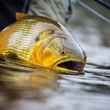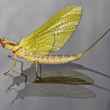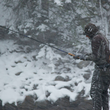Listen to those who are in-the-know on the many tailwaters across the country that produce regular high water flows, and they’ll likely tell you that you can’t catch fish on streamers in low, clear water. They’re dead wrong. But, to their credit, they’re kind of right.
When TVA turns on the generators at South Holston Dam, the river transforms. A slick, slow, gin-clear 100 CFS turns into a swift, rolling 2400 CFS, punctuated by pockets of ambush cover and holding water. The river’s biomass adjusts, shuffling to take cover and re-establish position. Amidst the shuffling, the system’s dominant, predatory brown trout go on the hunt, utilizing the cover of chaos to seal the deal on a big meal. It’s then that the dedicated streamer anglers pick up their sticks and start swimming big flies imitating baitfish, their audience having increased exponentially.
The water is generally still clear, but it’s moving a lot faster, and the same brown trout that were tucked away and cagey during low water become a lot more confident.
Still, the river is dynamic, and so varies the demeanors of individual fish. Given the same presentation, fish in swifter water are more prone to commit to the fly, while fish in slower, deeper habitat are more prone to following, as they have more time to study the movement and appearance of the fly while making a feeding decision, requiring the angler to think outside of the box and sell their fly harder.
Herein lies a dilemma that every angler targeting a predatory fish species will eventually encounter. How do you trigger predatory reactions in conditions not conducive to predation?
Poor Conditions
These same mechanisms also occur on natural rivers as seasons change, and as precipitation events alter streamflows and water clarity, daily. A rise in water levels often means swifter flow and an influx of debris and sediment, reducing visibility. As streamflows drop and slow, suspended particles settle, and the water clears.
Predators—coyotes, brown trout, and musky, alike—are most comfortable moving about and hunting when ambient conditions allow them to sneak up on their prey. It’s the reason coyote hunters stake out after dark, night fishing for giant brown trout is so effective, and why Esox fanatics recognize dark skies as “musky weather.”
And it’s why low, clear water and bright, sunny skies are a streamer angler’s worst nightmare. The underwater world is entirely lit up. There are no secrets, no veil of shadow for predators, no element of disorientation for prey items, and very little room for error on the part of the angler. However, success is still possible.

Speed Kills
The aforementioned tailwater example isolates one concept—how speed of presentation impacts success in lackluster streamer fishing conditions.
Under such conditions, rapid fly retrieves can trigger reactions from otherwise cautious fish. To start, fast presentations command a lot of attention in gin-clear water. They also force a predator to make a decision while they have the chance to pounce, robbing them of the opportunity to study and deliberate on the reality of your fly. And, in the case of fish like brown trout and musky that like to follow flies to the boat without committing, a fast retrieve usually results in a more amped-up (read, tunnel-visioned) fish, in close, which translates to more boatside eats (see “How to Execute an Effective Figure-Eight”).
There are a few different ways to incorporate speed as a trigger into your retrieve.
One method focuses on igniting a fish’s fight-or-flight instinct. It starts by slapping a fly down aggressively where you believe a fish to be holding and making the fly flee immediately upon entering the water. This method works particularly well when fish are using predictable ambush cover like logjams and rock piles, and has been a particularly valuable tool in my smallmouth and trout fishing. The splat will either surprise a lurking fish, or alert them to potential food entering their domain, and they’ll either spook or attack. And anyone who has ever been to bear country knows running from a predator generally ends badly.
Another option requires a bit of imagination and confidence. As you should always when streamer fishing, imagine a fish behind your fly from the moment it enters the water. Begin the retrieve with a moderately fast pace, and progressively speed the fly up as it approaches the boat, with the goal of having it near top speed by the time it gets boatside, incorporating short pauses every few seconds. This can be accomplished with either a single-hand or two-handed, saltwater-type retrieve, which is my preference. By doing this, you progressively walk a potentially interested fish through the stages of engagement, while providing fleeting opportunities to eat, and forcing any fish you may strip your fly past to pounce without much consideration. If a fish doesn’t eat your fly away from the boat, it’ll be a lot more amped up and less aware of your presence when it comes time to feed it beside the boat than it would be otherwise.
If you’re faced with low, clear water in a streamer fishing situation, consider spicing (and speeding) up your presentations to cagy fish. Once you’ve observed any predator’s reaction to speed in clear water, it’ll add a valuable skill to your bag of tricks and invaluable insight into the mind of a predator.






























Comments
Rowan Gliori replied on Permalink
Can confirm this works on brown and sea trout in low, clear flows in Scottish rivers too. I'm in a small minority of fly fishers here who actually use streamers the majority of the time, but it's by far my favourite method for separating out the sizeable fish.
Ariadne Capotis replied on Permalink
C'mon! two handed stripping in low and clear conditions and I'll get eats?? Hard to believe. Gonna have to try it . . .
Pages